Abstract
Background: For many years it has been studied how eye movements influence reading and learning ability. The objective of this study is to determine the relationships between the different publications and authors. As well as to identify the different areas of research ocular movement.; Methods: Web of Science was the database for the search of publications for the period 1900 to May 2021, using the terms: “Eye movement” AND “Academic achiev*”. The analysis of the publication was performed using the CitNetExplorer, VOSviewer and CiteSpace software.; Results: 4391 publications and 11033 citation networks were found. The year with the most publications is 2018, a total of 318 publications and 10 citation networks. The most cited publication was “Saccade target selection and object recognition: evidence for a common attentional mechanism.” published by Deubel et al. in 1999, with a citation index of 214. Using the Clustering function, nine groups were found that cover the main research areas in this field: neurological, age, perceptual attention, visual disturbances, sports, driving, sleep, vision therapy and academic performance.; Conclusion: Even being a multidisciplinary field of study, the topic with the most publications to date is the visual search procedure at the neurological level.
Introduction
Ocular motility has been studied since the 20th century (); therefore, the first era on the research of eye movements dates from 1879 to 1920 (). In recent years, as stated by Bilbao & Piñero (2020), researchers have developed a great interest about this topic. Within eye movement, those which are present while reading must be highlighted, tracking movements, saccadic movements, regressions and solidity during fixation, since this is a key process in the learning development of school-age children (Bilbao & Piñero, 2020).
During reading processes, the eyes move through the text making a series of saccadic movements with different ranges and directions as well as different fixations with variable durations. These movements tend to go in a forward direction, that is to say, the eyes fixate on one word before moving onto another. However, in order to fixate on a previous word, or to move to the next line of the text, a backwards movement is performed (regression). Saccadic movements are the fastest movement that the human body is capable of performing, with an average speed of 100° to 800° per second and a frequency of 100,000 saccades per day ().
The necessary skills, which are most influenced by vision, to achieve a good academic performance are: a fluent reading, precision and a good understanding of the text. These skills depend on eye movements (; Faber et al., 2020). The tracking eye movement is considered as a tool that can be used to investigate, in realtime, the cognitive processes that are involved in reading. Studies have shown that readers with faster reading speeds tend to have fewer and shorter fixations, larger saccadic movements, fewer regressions and more extended perception periods when reading sentences and texts (; ; ; ). On the other hand, highly able readers presented with short fixations and fewer regressions than average readers (; ). A recent study conducted by (), found that children with an average or higher reading ability had better control of their vertical and horizontal eye movements and they also made a greater number of eye movements between the lines than those with lower reading abilities.
Eye movements have many functions in a range of everyday tasks, given that these work in coordination with body and head movements. In social interactions, eye movements provide us with information (i.e.,: by looking at someone’s face or following their look) and indicate that we are looking at someone in particular. In other words, eye movements serve an additional purpose as a communicative signal. On the other hand, for example while driving, the interaction between head and eye movements is complex, therefore meaning that saccadic movements, smooth pursuit vergence eye movements and the vestibulo-ocular reflex are required (; ; ).
Citation network analysis is a powerful tool, which allows us to analyse, classify and deepen the scientific literature on a specific subject. Moreover, through this type of analysis is it possible to determine the most cited article and create groups that allow for links between articles and authors to be established. This therefore means that it is a great tool for broadening our knowledge on a specific field of interest ().
This study presents an analysis of citation networks. In which the relationship between authors and publications is analysed. As well as an in-depth analysis of the research areas with the greatest interest within the research field of the influence of eye movements on academic performance.
Methods
Database
The search of publications was carried out in the Web of Science (WOS) database, using the following search terms: “Eye movement” AND “Academic achiev*”. These terms were used in accordance with the aim of this study, how eye movements influence academic performance.
As the search results had articles in common, the Boolean operator “NOT” was used, as well as the truncation symbol “*”, which was used to search for the singular and plural forms of the terms. Therefore, in the second search we used the following terms: (“Eye movement*” AND “Academic performance” NOT “Academic achiev*”), in the third search we used the following terms: (“Eye movement*” AND “Binocular vision” NOT “Academic performance” NOT “Academic achiev*”), and in the fourth search, the following terms: (“Eye movement*” AND “Visual performance*” NOT “Binocular vision” NOT “Academic performance” NOT “Academic achiev*”). The selected time interval to carry out the search was from 1900 to May 2021.
Data Analysis
Once the Web of Science bibliography is downloaded by exporting plain text files, it is loaded into the CitNetExplorer software. CitNetExplorer software [(Centre for Science and Technology Studies), Leiden, The Netherlands] has been used for the analysis of publications and the creation of citation networks.
Using the Citation Score attribute, the quantitative analysis was performed, in order to quantify the internal connections of the Web of sciences database and other external databases (Current Contents Connect, Data Citation Index, Derwent Innovations Index, KCI-Korean Journal Database, Medline, Russian Science Citation Index, ScIELO Citation Index).
First, the clustering function has been used, which is based on the formula developed by VanEck in 2012 (), where ci denotes the cluster to which node i is assigned, δ(ci, cj) denotes a function that equals 1 if ci = cj and 0 otherwise, and γ denotes a resolution parameter that determines the level of detail of the clustering. The higher the value of γ, the larger the number of clusters that will be obtained. This formula allows to obtain the connections between the publications

Secondly, the “core Publications” function has been used, which consists of identifying the publications that are considered to be at the core of a citation network. Only publications with 4 or more citations were considered.
For the use of The CiteSpace software (5.6.R2), the bibliography downloaded from the Web of Science is also used. First, the period of years to be analyzed is selected. Next, it is selected based on what you want to analyse, the country, the institutions, authors, keyword, etc.; and thus obtain the following parameters: H Index (number and level of scientific production of authors and institutions). Degree (number of connections between authors, institutions, countries, etc.). Centrality (Determines the importance of the nodes in the research cooperation network, and the half-life is a parameter that represents the continuity of institutional research from a temporal perspective).
VOSviewer software allows the visualization and creation of bibliometric networks. Therefore, it was used for creating the graphs. To obtain the graphs, the CitNetexplorer software groups are downloaded in the Pakej format. Next, this file is loaded in Vosviewer in the CreateCreate a map based on network data section.
On the other hand, the Web of Science and Scimago Journal & Country Rank databases have been used to obtain bibliometric data and the impact of the journals.
Results
The first articles on eye movements were published in 1976. The period of study was from 1900 to May 2021. Through the WOS search, 4391 publications and 11033 citation networks were found.
As shown in Figure 1, the number of publications on eye movements increased exponentially since 2005, more than 100 publications per year, (1976–2004: 19.7% of publications; 2005–2021: 80.2% of publications). 2018 was the year with the highest number of publications: 318 publications and 10 citation networks.

Figure 1.
Number of publications per year.
Table 1 shows the 20 most cited publications within this citation network. The most cited article was written by Deubel et al. (1996), which was published in 1998 and has a citation index of 213. This article analysed the spatial interaction and the saccadic movements of the eyes. Therefore, the data showed that visual discrimination is better when the discrimination stimuli and the saccadic movement move toward the same object. That is to say, it is difficult to direct the attention to the object that is being discriminated whilst the saccadic movement moves towards another close object. In conclusion, the obtained data highlighted the importance of a compulsory and selective link between the saccadic programming and the visual attention towards an object in common.

Table 1.
20 most cited publications.
After having analysed the 20 most cited articles, 10 of them concern the visual search procedure in primates on a neurological level (; ; ; ; ; ; ; ; ; ), 3 of them addressed the neuronal mechanisms that generate the saccadic movements and how these vary with age (; ; ), 3 addressed the association between saccadic movements and the perceptive attention (; ; ), 3 considered the importance of ocular-motor movements within the sports field (; ; ), and one of them was about ocular-motor movements in patients with alterations in their field of vision ().
Description of the Publications
Of all publications, 84.8% were articles, 6.1% were proceedings papers, 5.9% were reviews, and the remaining 3.2% were meeting abstracts, book chapter or editorial materials. With regards to the language of the publications, 99% were in English, 0.8% were in German and the remaining 0.2% were in Russian. As shown in Figure 2 and Table 2, the countries with the highest number of publications were the United States (33.9%), England (14.9%) and Germany (13.1%). Figure 2 shows the collaboration amongst countries, as well as the group they belong to. The colour of an article represents the group they belong to and the lines among elements represent their strength.
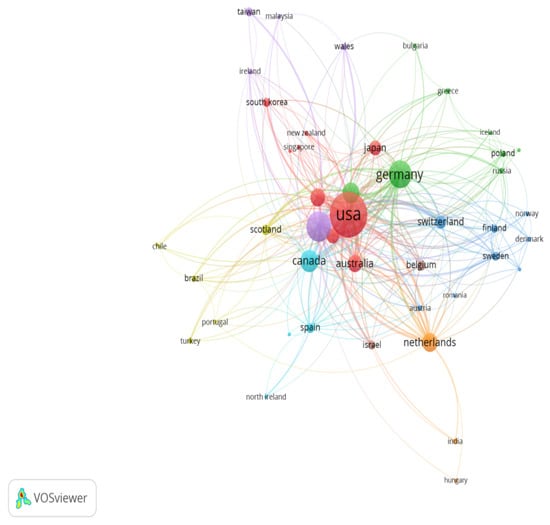
Figure 2.
Collaboration amongst countries.

Table 2.
Characteristics of the main countries.
The research area on eye movements is multidisciplinary. It is worth noting the field of Psychology (34.7%) and Neuroscience (34.2%) (Table 3).

Table 3.
Top 10 research areas with the highest number of publications.
The institutions with the highest number of publications (Table 4) were University of Toronto (1.8%), New York University (1.5%) and University of Tubingen (1.5%). Table 5 shows the main journals and the number of publications that have published on eye movements.

Table 4.
Top 10 institutions with the highest number of publications.

Table 5.
Top 20 journals with the most publications.
The most commonly used keywords were “Eyemovements”, “Attention”, “Performance”, “Saccadic Eye movements” and “Perception”.
Table 6 shows the most used keywords in the most relevant publications.

Table 6.
Top 20 most used keywords.
Clustering Function
Using the Clustering function, 13 groups were found, nine of which had a significant number of publications. The remaining four groups only made up 1.2% of the publications, which did not have enough publications to obtain connections between authors and publications.
Group 1 includes 692 publications and 2184 citations. The most-cited work is () in Vision Research. This study describes a computerized implementation of the two-dimensional map that encodes the prominence or visibility of objects in the visual environment. That is, the competition between neurons means that there is a single winning location that corresponds to the next attended target. If this location is inhibited, the system will attend to the next most prominent location. This computational model combines stimulus-driven orientation, intensity, and colour information to address the extent to which the primate visual system can carry out visual search via one or more such saliency maps and how this can be tested.
The scientific references in this group analyse the visual search procedure at the neurological level (Figure 3).
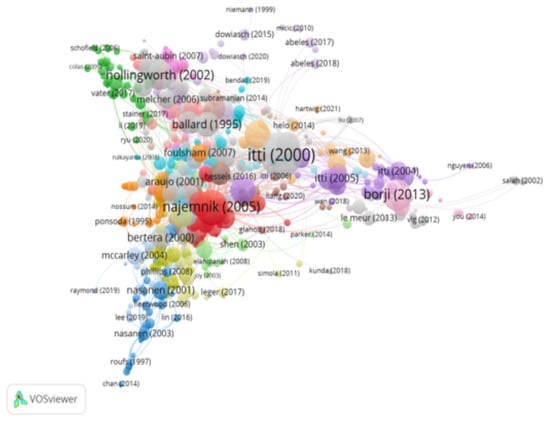
Figure 3.
Citation network in Group 1.
Group 2 comprises 536 publications and 1500 citations. The most-cited work is () in Experimental Brain Research. This study suggests how saccadic movements change with age by quantifying the percentage of direction errors, the time to onset of the eye movement (saccadic reaction time: SRT) and the metrics and dynamics of the movement itself. The results show that children aged 5–8 years have very slow SRTs, but there is a great intra-subject variance in SRT, and, at the same time, they present the most direction errors in the anti-saccade task. Subjects aged 20–30 years have the fastest SRTs and lowest intra-subject variance in SRT. SRTs are slower and with longer saccades in subjects aged 60 to 79 years than other groups of subjects. This demonstrates very strong age-related changes, which can reflect different stages of normal development and degeneration of the nervous system. The improvement in performance in the anti-saccade task that occurs between the ages of 5 to 15 years is attributed to the maturation of the frontal lobes. The scientific references in this group analyse the neural mechanisms responsible for the generation of saccadic movements and how they change with age (Figure 4).
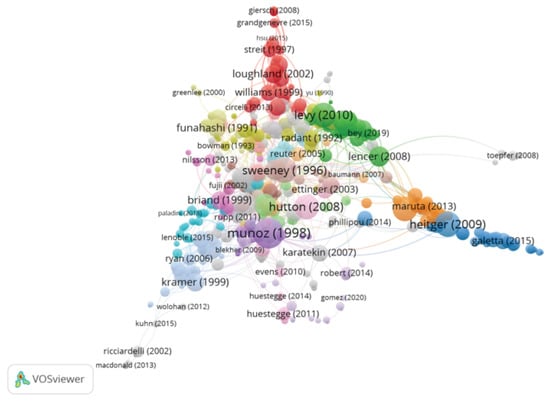
Figure 4.
Citation network in Group 2.
Group 3 includes 384 publications and 1209 citations. The most-cited work is () in Vision Research, which also ranks first among the 20 most cited publications. The scientific references in this group analyse the association between saccadic eye movements and perceptual attention (Figure 5).
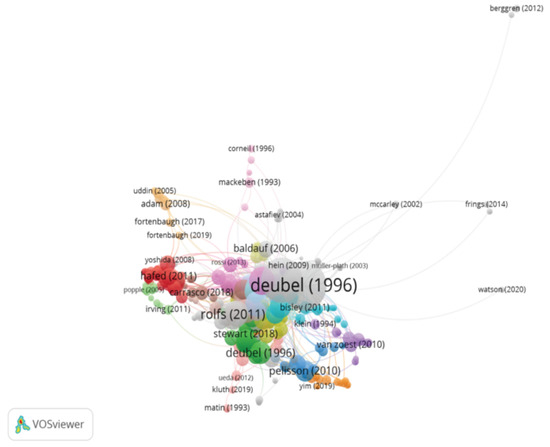
Figure 5.
Citation network in Group 3.
Group 4 comprises 264 publications and 910 citations. The most-cited work is () in Neuropsychologia. This study analyses eye movements in a group of patients suffering from homonymous hemianopia due to postgeniculate damage. After visual training, all patients show a significant improvement in visual searching (that is, the spatial organization of visual exploration was improved), indicating that a good oculomotor system can substitute the lost visual hemifield.
The scientific references in this group examine eye movements in patients with visual disturbances (Figure 6).
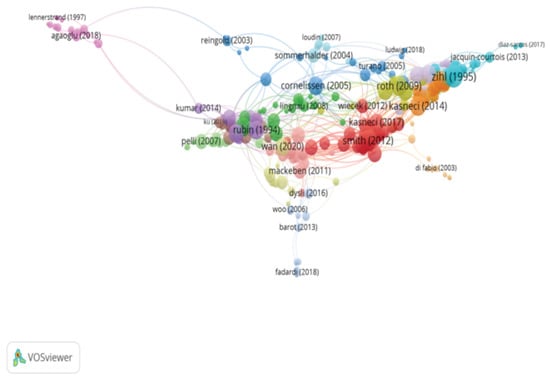
Figure 6.
Citation network in Group 4.
Group 5 includes 253 publications and 809 citations. The most-cited work is () in Journal of sports sciences.
This study analyses the skills of anticipation and visual search in expert and novice soccer goalkeepers. Expert goalkeepers are generally more accurate. That is, they use a more efficient search strategy involving fewer fixation. No differences in visual search behaviour are observed between successful and unsuccessful penalties.
The scientific references in this group discuss the importance of oculomotor movements in sports (Figure 7).
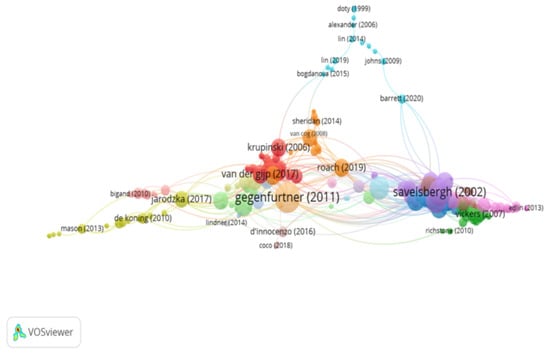
Figure 7.
Citation network in Group 5.
Group 6 comprises 249 publications and 474 citations. The most-cited work is () in Accident analysis and prevention. This study examines the eye movements of driving instructors and learner drivers while they drive three virtual routes under different visibility conditions. The results show that eye movement strategies improve with driving experience. The high accident risk of night and rain driving could be partly explained by the decrement in visual search strategies during these conditions.
The scientific references in this group assess the importance of eye movements in driving (Figure 8).
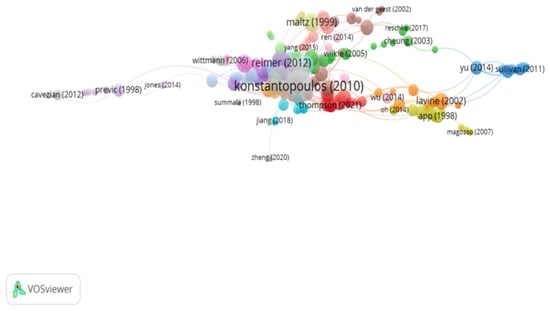
Figure 8.
Citation network in Group 6.
Group 7 includes 232 publications and 477 citations. The most-cited work is () in Journal of Neurophysiology. The study aims to examine the activity of individual neurons in the posterior parietal cortex of two rhesus monkeys by discriminating the direction of movement on random point visual stimuli. The results show that stronger movement leads to larger neural responses early in the movement display period or when the direction of movement is towards the response field. However, greater suppression occurs, when the movement moves away from the response field. In this sense, individual neurons in the posterior parietal cortex display the information of gaze changes and the sensory information that instructs such a response. The time course of the neural response suggests that the posterior parietal cortex accumulates sensory signals relevant to the selection of a target for an eye movement.
The scientific references in this group discuss the importance of cortical areas in eye movements, as well as changes in eye movements during sleep (Figure 9).
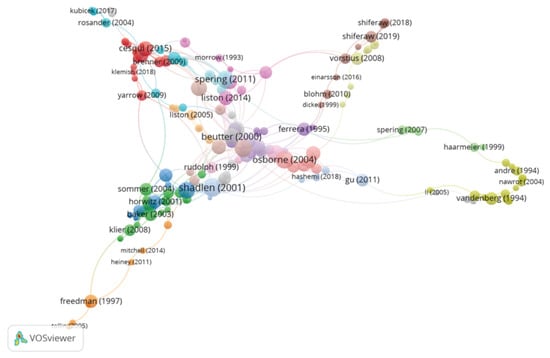
Figure 9.
Citation network in Group 7.
Group 8 comprises 188 publications and 444 citations. The most-cited work is () in Optometry and Vision Science. This research quantifies the clinical measurements and functional neuronal changes associated with vision therapy in patients with convergence insufficiency (CI). The findings show that the maximum speed of convergence is significantly slower in CI subjects compared to controls, which can result in asthenopic complaints in CI patients. Vision therapy can be associated with changes in clinical and cortical activity.
The scientific references in this group highlight the importance of eye movements in near vision tasks and their training using vision therapy (Figure 10).
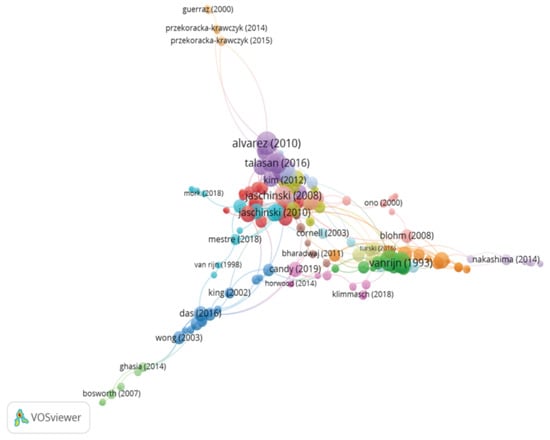
Figure 10.
Citation network in Group.
Group 9 includes 175 publications and 322 citations. The most-cited work is () in Journal of Research in Reading. This study focusses on the role of visual attention span on the development of reading skills in children. The results show that learning to read is influenced by the capacity for visual attention. In turn, visual attention span has a significant and sustained influence in all grades for irregular words. On the other hand, it is suggested that it could influence the acquisition of specific spelling knowledge over time.
At a general level, the scientific references in this group describe the importance of eye movements in school performance (Figure 11).
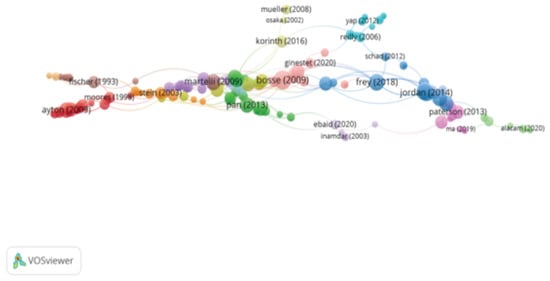
Figure 11.
Citation network in Group 9.
Core Function
1452 collected publications have four or more citations, representing 33% of the total citation network (7008). In other words, the field of eye movement research is multidisciplinary.
Discussion
Major databases such as WOS or Scopus allow for the creation of citation networks. However, it is not possible to perform a systematic review of all of the existing scientific literature published on a topic, given that this does not provide a general overview of the connections between the citations of a group of publications. For this reason, the CitNetExplorer software was used, as, besides creating citation networks, it also offers a more detailed analysis of the scientific literature than the WOS or Scopus databases ().
The general objective of the present study was to analyse the existing scientific literature on ocular motility. The source of publications was the WOS database, which only accepts prestigious international journals after a rigorous selection process, and whose search range begins in the year 1900.
Therefore, once the bibliography had been downloaded from the WOS database, the CitNetExplorer software allowed us to collect and analyse every available piece of literature on ocular motility from 1900 to May 2021. In addition, it was also possible to obtain the connections between the fields of study and the different research groups by analysing the citation networks. The “Clustering” function allowed us to obtain the results and group the publications according to the links between the citations. The “Core publications” function was used to select the most cited publications (that is, those studies with a minimum number of citations). Those publications with 4 or more citations were selected according to other studies (). All these functions allow for a complete analysis of the publications related to the research field of interest (in this case, ocular motility).
Vision Research, with an impact factor of 2.61, was the journal with the highest number of publications (213) on ocular motility. In turn, the journal with the highest impact factor was The Journal of Neuroscience with 5.67. In any case, it is important to consider that the impact factor is a critical index of the journal’s importance but it is not an absolute index. The main difference between a critical index and an absolute index is that the latter is based on the impact of the research results and the authors’ physical and intellectual contributions ().
However, the Journal of Eye Movement Research, since 2016, is the journal that has most increased its publications on eye movements and the impact they can have on academic performance (; ; ; ; ). This may be because it is an eye movement-specific, peer-reviewed, open access journal devoted to all aspects of oculomotor functioning, including eye recording methodology, neurophysiological and cognitive models, attention, reading, as well as applications in neurology, ergonomics, media research. However, the article with the greatest impact was that of (), in which they compared the distribution of visual attention between subtitles and other sources of information through eye tracking and related this to academic comprehension and cognitive load measured through self-report questionnaires and electroencephalogram.
The country with the highest publication rate was the United States (33.9%), followed by England (14.9%) and Germany (13.1%). Our results agree with the study by (). This suggests that these countries have a high interest in the influence of multiple factors at the academic level.
Among the first publications in this field of research, the articles by (), with a citation index of 19, and (), with a citation index of 30, are particularly worth mentioning given the number of citations. In the first study, the authors used the adaptive tracking test, smooth pursuit analysis, saccadic eye movements, and visual analogue lines to analyze the effects of single oral doses of 5, 10, and 20 mg of Temazepam on eye movements. It was observed that Temazepam (20 mg) caused effects in all trials, with the maximum effect occurring after 30 minutes. The 10 mg dose affected saccadic eye movements, and the 5 mg dose was detected only by analyzing saccadic eye movements ().
In (), the authors corroborated the hypothesis that testing working memory beyond a certain threshold could result in decreased inhibition, with behavior resembling the errors made by patients with prefrontal dysfunction.
From 2013 to date, the curve of publications on eye movements has been steadily increasing, perhaps due to the increasing interest in the importance of vision on academic performance in recent years, and therefore the relevant role played by eye movements (; ; ; ; ; ). For example, () affirmed that reading is fundamental for the proper development of the learning process and good academic performance, emphasising the key role that saccades play in optimal reading development. Recently, () used the ReadAlyzer Eye Movement recording system to conduct an objective assessment of eye movements on 30 subjects who presented with traumatic brain injury (TBI) and 60 control subjects. The TBI subjects showed a significant reduction in the measured parameters (fixations, regressions, reading rate, equivalent grade level, and reading comprehension) compared to those in the control group. () published a study in the American Academy of Optometry (AAO) in which the Visagraph Eye Movement recording system was used to analyse eye movement patterns in reading. In this case, 21 of the 41 subjects had attention deficit hyperactivity disorder (ADHD) and 20 were control subjects. All of the subjects orally read a standardised text that was suitable for their age group. The results showed that the ADHD subjects had worse eye movement patterns than the control group. These two studies analysed the quality of eye movements on reading in subjects with neurological disorders, with both obtaining similar results.
The year with the highest number of “key year” publications on eye movements was 2018. In this year, the study by (), which exposed how the presence of an attentional distractor affects integration performance both before saccadic movement onset and during saccadic movement execution is particularly worth mentioning. This study suggested that visual attention may be a mechanism for facilitating transsaccadic integration. Another publication by (), concluded that saccadic movements exert spatially selective biases on stable representations in visuospatial working memory (VSWM).
Consequently, eye movements are present in all areas of daily life. Therefore, in recent years there has been an increasing amount of research conducted into the ways in which eye movements vary with age and how they influence memory (; ; ). Image encoding is related to eye movements and declines in spatial memory may be associated with a specific decline in spatial processing rather than general age-related declines in terms of cognition. However, the reduction in learning ability does not appear to be affected by changes in the control of visual attention through eye-tracking, nor by changes in attentional engagement.
Another topic of interest, although to a lesser extent, is the importance of eye movements in sports vision (; ). It has been observed that elite players present a better visual search strategy than mid-level players, therefore suggesting that the position and situation of teammates and opponents are relevant sources of information that enable players to make accurate and consistent passing decisions.
In conclusion, by analyzing citation networks it has been possible to extend knowledge about eye movements. Nine groups were identified in this study (age, sports vision, school performance, visual field disturbances, visual therapy, sleep, neurology, driving, and perceptual attention), therefore meaning that the field of research on eye movements is multidisciplinary. The topic with the most publications to date is the visual search procedure at the neurological level. However, research topics on the importance of eye movements with age and sports vision have gained growing interest in recent years.
Conflicts of Interest
The author(s) declare(s) that the contents of the article are in agreement with the ethics described in https://bib-lio.unibe.ch/portale/elibrary/BOP/jemr/ethics.html and that there is no conflict of interest regarding the publication of this paper.
References
- Alvarez, T. L., V. R. Vicci, Y. Alkan, E. H. Kim, S. Gohel, A. M. Barrett, N. Chiaravalloti, and B. B. Biswal. 2010. Vision therapy in adults with convergence insufficiency: Clinical and functional magnetic resonance imaging measures. Optometry and Vision Science: Official Publication of the American Academy of Optometry 87, 12: E985–E1002. [Google Scholar] [CrossRef]
- Ashby, J., K. Rayner, and C. Clifton. 2005. Eye movements of highly skilled and average readers: Differential effects of frequency and predictability. The Quarterly journal of experimental psychology. A, Human Experimental Psychology 58, 6: 1065–1086. [Google Scholar] [CrossRef] [PubMed]
- Ballard, D. H., M. M. Hayhoe, and J. B. Pelz. 1995. Memory representations in natural tasks. Journal of Cognitive Neuroscience 7, 1: 66–80. [Google Scholar] [CrossRef]
- Barnes, G. R. 2008. Cognitive processes involved in smooth pursuit eye movements. Brain and Cognition 68, 3: 309–326. [Google Scholar] [CrossRef] [PubMed]
- Beelders, T., and J. P. Plessis. 2016. Syntax highlighting as an influencing factor when reading and comprehending source code. Journal of Eye Movement Research 9, 1: 2207–2219. [Google Scholar] [CrossRef]
- Bertera, J. H., and K. Rayner. 2000. Eye movements and the span of the effective stimulus in visual search. Perception & Psychophysics 62, 3: 576–585. [Google Scholar]
- Bilbao, C., and D. P. Piñero. 2020. Clinical Characterization of Oculomotricity in Children with and without Specific Learning Disorders. Brain Sciences 10, 11: 836. [Google Scholar] [CrossRef]
- Bilbao, C., and D. P. Piñero. 2020. Diagnosis of oculomotor anomalies in children with learning disorders. Clinical & Experimental Optometry 103, 5: 597–609. [Google Scholar]
- Birch, E. E., and K. R. Kelly. 2017. Pediatric ophthalmology and childhood reading difficulties: Amblyopia and slow reading. Journal of AAPOS: The Official Publication of the American Association for Pediatric Ophthalmology and Strabismus 21, 6: 442–444. [Google Scholar] [CrossRef]
- Biswal, A. K. 2013. An absolute index (Ab-index) to measure a researcher’s useful contributions and productivity. PLoS ONE 8, 12: e84334. [Google Scholar] [CrossRef]
- Borges, M. T., E. G. Fernandes, and M. I. Coco. 2020. Age-related differences during visual search: The role of contextual expectations and cognitive control mechanisms. Neuropsychology, Development, and Cognition. Section B, Aging, Neuropsychology and Cognition 27, 4: 489–516. [Google Scholar] [CrossRef] [PubMed]
- Borji, A., and L. Itti. 2013. State-of-the-art in visual attention modeling. IEEE Transactions on Pattern Analysis and Machine Intelligence 35, 1: 185–207. [Google Scholar] [CrossRef]
- Bosse, M. L., and S. Valdois. 2009. Influence of the visual attention span on child reading performance: A cross-sectional study. Journal of Research in Reading 32: 230–253. [Google Scholar] [CrossRef]
- Christen, M., and M. Abegg. 2016. The Effect of Magnification and Contrast on Reading Performance in Different Types of Simulated Low Vision. Journal of Eye Movement Research 10, 2. [Google Scholar] [CrossRef]
- Deubel, H., and W. X. Schneider. 1996. Saccade target selection and object recognition: Evidence for a common attentional mechanism. Vision Research 36, 12: 1827–1837. [Google Scholar] [CrossRef] [PubMed]
- Dodge, R. 1903. Five types of eye movement in the horizontal meridian plane of the field of regard. American Journal of Physiology 8: 307–329. [Google Scholar] [CrossRef]
- Everatt, J., and G. Underwood. 1994. Individual differences in reading subprocesses: Relationships between reading ability, lexical access, and eye movement control. Language and Speech 37, Pt 3: 283–297. [Google Scholar] [CrossRef]
- Everling, S., and B. Fischer. 1998. The antisaccade: A review of basic research and clinical studies. Neuropsychologia 36, 9: 885–899. [Google Scholar] [CrossRef]
- Feis, A., A. Lallensack, E. Pallante, M. Nielsen, N. Demarco, and B. Vasudevan. 2021. Reading Eye Movements Performance on iPad vs Print Using a Visagraph. Journal of eye Movement Research 14, 2. [Google Scholar] [CrossRef]
- Foulsham, T. 2015. Eye movements and their functions in everyday tasks. Eye (London, England) 29, 2: 196–199. [Google Scholar] [CrossRef]
- Gegenfurtner, A., E. Lehtinen, and R. Säljö. 2011. Expertise differences in the comprehension of visualizations: A meta-analysis of eye-tracking research in professional domains. Educational Psychology Review. 23, 523–552. [Google Scholar] [CrossRef]
- Gidfol, K., A. Wallin, R. Dewhurst, and K. Holmqvist. 2013. Using Eye Tracking to Trace a Cognitive Process: Gaze Behaviour During Decision Making in a Natural Environment. Journal of Eye Movement Research 6, 1. [Google Scholar]
- González, C. M. 2009. Análisis de citación y de redes sociales para el estudio del uso de revistas en centros de investigación: An approach to the development of collections. Ciência da Informção 38, 2: 46–55. [Google Scholar] [CrossRef]
- Häikiö, T., R. Bertram, J. Hyönä, and P. Niemi. 2009. Development of the letter identity span in reading: Evidence from the eye movement moving window paradigm. Journal of Experimental Child Psychology 102, 2: 167–181. [Google Scholar] [CrossRef] [PubMed]
- Haist, F., J. H. Wazny, E. Toomarian, and M. Adamo. 2015. Development of brain systems for nonsymbolic numerosity and the relationship to formal math academic achievement. Human Brain Mapping 36, 2: 804–826. [Google Scholar] [CrossRef] [PubMed]
- Hayhoe, M. M., A. Shrivastava, R. Mruczek, and J. B. Pelz. 2003. Visual memory and motor planning in a natural task. Journal of Vision 3, 1: 49–63. [Google Scholar] [CrossRef] [PubMed]
- Hernandez-Torre, D., and H. Yuh-Shan. 2021. A Bibliometric Analysis of Publications in the Web of Science Category of Educational Psychology in the Last Two Decades. Psicología Educativa 27, 2: 101–113. [Google Scholar] [CrossRef]
- Hilton, C., S. Miellet, T. J. Slattery, and J. Wiener. 2020. Are age-related deficits in route learning related to control of visual attention? Psychological Research 84, 6: 1473–1484. [Google Scholar] [CrossRef]
- Hindmarsh, G. P., A. A. Black, S. L. White, S. Hopkins, and J. M. Wood. 2021. Eye movement patterns and reading ability in children. Ophthalmic & Physiological Optics: The Journal of the British College of Ophthalmic Opticians (Optometrists) 41, 5: 1134–1143. [Google Scholar]
- Hollingworth, A., and J. M. Henderson. 2002. Accurate visual memory for previously attended objects in natural scenes. Journal of Experimental Psychology: Human Perception and Performance 28, 1: 113–136. [Google Scholar] [CrossRef]
- Hopkins, S., A. A. Black, S. White, and J. M. Wood. 2019. Visual information processing skills are associated with academic performance in Grade 2 school children. Acta Ophthalmologica 97, 8: e1141–e1148. [Google Scholar] [CrossRef] [PubMed]
- Itti, L., and C. Koch. 2000. A saliency-based search mechanism for overt and covert shifts of visual attention. Vision Research 40, 10–12: 1489–1506. [Google Scholar] [CrossRef] [PubMed]
- Jared, D., B. A. Levy, and K. Rayner. 1999. The role of phonology in the activation of word meanings during reading: Evidence from proofreading and eye movements. Journal of experimental psychology. General 128, 3: 219–264. [Google Scholar] [CrossRef]
- Kirk, H. E., K. Gray, D. M. Riby, J. Taffe, and K. M. Cornish. 2017. Visual attention and academic performance in children with developmental disabilities and behavioural attention deficits. Developmental Science 20, 6. [Google Scholar] [CrossRef]
- König, P., N. Wilming, T. Kietzmann, J. Ossandón, S. Onat, B. Ehinger, R. Gameiro, and K. Kaspar. 2016. Eye movements as a window to cognitive processes. Journal of Eye Movement Research 9, 5. [Google Scholar] [CrossRef]
- Konstantopoulos, P., P. Chapman, and D. Crundall. 2010. Driver’s visual attention as a function of driving experience and visibility. Using a driving simulator to explore drivers’ eye movements in day, night and rain driving. Accident; analysis and prevention 42, 3: 827–834. [Google Scholar] [CrossRef]
- Krieber, M., K. D. Bartl-Pokorny, F. B. Pokorny, C. Einspieler, A. Langmann, C. Körner, T. Falck-Ytter, and P. B. Marschik. 2016. The Relation between Reading Skills and Eye Movement Patterns in Adolescent Readers: Evidence from a Regular Orthography. PLoS ONE 11, 1: e0145934. [Google Scholar] [CrossRef] [PubMed]
- Kruger, J., E. Hefer-Jordaan, and G. Matthew. 2014. Attention distribution and cognitive load in a subtitled academic lecture: L1 vs. L2. Journal of Eye Movement Research 7, 5: 1–15. [Google Scholar] [CrossRef]
- Kowler, E., E. Anderson, B. Dosher, and E. Blaser. 1995. The role of attention in the programming of saccades. Vision Research 35, 13: 1897–1916. [Google Scholar] [CrossRef]
- Magyari, L., A. Mangen, A. Kuzmičová, A. M. Jacobs, and J. Lüdtke. 2020. Eye movements and mental imagery during reading of literary texts with different narrative styles. Journal of Eye Movement Research 13, 3. [Google Scholar] [CrossRef]
- Molina, R., B. Redondo, J. Vera, J. A. García, A. MuñozHoyos, and R. Jiménez. 2020. Children with Attention-deficit/Hyperactivity Disorder Show an Altered Eye Movement Pattern during Reading. Optometry and Vision Science: Official Publication of the American Academy of Optometry 97, 4: 265–274. [Google Scholar] [CrossRef] [PubMed]
- Moore, T., and M. Fallah. 2001. Control of eye movements and spatial attention. Proceedings of the National Academy of Sciences of the United States of America 98, 3: 1273–1276. [Google Scholar] [CrossRef]
- Munoz, D. P., J. R. Broughton, J. E. Goldring, and I. T. Armstrong. 1998. Age-related performance of human subjects on saccadic eye movement tasks. Experimental Brain Research 121, 4: 391–400. [Google Scholar] [CrossRef] [PubMed]
- Najemnik, J., and W. S. Geisler. 2005. Optimal eye movement strategies in visual search. Nature 434, 7031: 387–391. [Google Scholar] [CrossRef]
- Navalpakkam, V., and L. Itti. 2005. Modeling the influence of task on attention. Vision Research 45, 2: 205–231. [Google Scholar] [CrossRef] [PubMed]
- Narayanasamy, S., S. J. Vincent, G. P. Sampson, and J. M. Wood. 2015. Simulated astigmatism impairs academic-related performance in children. Ophthalmic & Physiological Optics: The Journal of the British College of Ophthalmic Opticians (Optometrists) 35, 1: 8–18. [Google Scholar]
- Natsuhara, T., T. Kato, M. Nakayama, T. Yoshida, R. Sasaki, T. Matsutake, and T. Asai. 2020. DecisionMaking While Passing and Visual Search Strategy During Ball Receiving in Team Sport Play. Perceptual and Motor Skills 127, 2: 468–489. [Google Scholar] [CrossRef]
- Ohl, S., and M. Rolfs. 2018. Saccadic selection of stabilized items in visuospatial working memory. Consciousness and Cognition 64: 32–44. [Google Scholar] [CrossRef]
- Rao, R. P., G. J. Zelinsky, M. M. Hayhoe, and D. H. Ballard. 2002. Eye movements in iconic visual search. Vision Research 42, 11: 1447–1463. [Google Scholar] [CrossRef]
- Ralph, J. R., L. D. Hager, and H. Christine. 1994. Prefrontal cognitive processes: Working memory and inhibition in the antisaccade task. Journal of Experimental Psychology: General 123, 4: 374–393. [Google Scholar]
- Rayner, K. 1998. Eye movements in reading and information processing: 20 years of research. Psychological Bulletin 124, 3: 372–422. [Google Scholar] [CrossRef]
- Rayner, K., T. J. Slattery, and N. N. Bélanger. 2010. Eye movements, the perceptual span, and reading speed. Psychonomic Bulletin & Review 17, 6: 834–839. [Google Scholar]
- Reddy, A., R. Mani, A. Selvakumar, and J. R. Hussaindeen. 2020. Reading eye movements in traumatic brain injury. Journal of Optometry 13, 3: 155–162. [Google Scholar] [CrossRef]
- Savelsbergh, G. J., A. M. Williams, J. Van der Kamp, and P. Ward. 2002. Visual search, anticipation and expertise in soccer goalkeepers. Journal of Sports Sciences 20, 3: 279–287. [Google Scholar] [CrossRef] [PubMed]
- Schall, J. D. 1991. Neuronal activity related to visually guided saccadic eye movements in the supplementary motor area of rhesus monkeys. Journal of Neurophysiology 66, 2: 530–558. [Google Scholar] [CrossRef]
- Segen, V., M. N. Avraamides, T. J. Slattery, and J. M. Wiener. 2021. Age-related differences in visual encoding and response strategies contribute to spatial memory deficits. Memory & Cognition 49, 2: 249–264. [Google Scholar]
- Seung Won, P., and K. ChanMin. 2015. The effects of a virtual tutee system on academic reading engagement in a college classroom. Educational Technology Research and Development 64, 2. [Google Scholar]
- Shadlen, M. N., and W. T. Newsome. 2001. Neural basis of a perceptual decision in the parietal cortex (area LIP) of the rhesus monkey. Journal of Neurophysiology 86, 4: 1916–1936. [Google Scholar] [CrossRef]
- Smidekova, Z., M. Janik, E. Minarikova, and K. Holmqvist. 2018. Teachers’ gaze over space and time in a real-world classroom. Journal of Eye Movement Research 13, 4. [Google Scholar] [CrossRef]
- Stewart, E., and A. C. Schütz. 2018. Attention modulates trans-saccadic integration. Vision Research 142: 1–10. [Google Scholar] [CrossRef]
- Tatler, B. W., M. M. Hayhoe, M. F. Land, and D. H. Ballard. 2011. Eye guidance in natural vision: Reinterpreting salience. Journal of Vision 11, 5: 5. [Google Scholar] [CrossRef]
- Van Eck, N. J., and L. Waltman. 2014. CitNetExplorer: A new software tool for analyzing and visualizing citation networks. Journal of Informetrics 8: 802–823. [Google Scholar] [CrossRef]
- Vater, C., A. Williams, and E. Hossner. 2019. What do we see out of the corner of our eye? The role of visual pivots and gaze anchors in sport. International Review of Sport and Exercise Psychology 13, 1: 1–23. [Google Scholar] [CrossRef]
- Vikesdal, G., and T. Langaas. 2016. Saccade Latency and Fixation Stability: Repeatability and Reliability. Journal of Eye Movement Research 9, 2. [Google Scholar]
- Vinker, P. 2019. Core journals and elite subsets in scientometrics. Scientometrics 121: 241–259. [Google Scholar] [CrossRef]
- Williams, A. M., and K. Davids. 1998. Visual search strategy, selective attention, and expertise in soccer. Research Quarterly for Exercise and Sport 69, 2: 111–128. [Google Scholar] [CrossRef]
- Wood, J. M., A. A. Black, S. Hopkins, and S. White. 2018. Vision and academic performance in primary school children. Ophthalmic & Physiological Optics: The Journal of the British College of Ophthalmic Opticians (Optometrists) 38, 5: 516–524. [Google Scholar]
- Zihl, J. 1995. Visual scanning behavior in patients with homonymous hemianopia. Neuropsychologia 33, 3: 287–303. [Google Scholar] [CrossRef]
© 2022 by the authors. This article is licensed under a Creative Commons Attribution 4.0 International License.